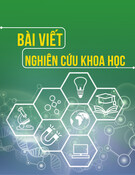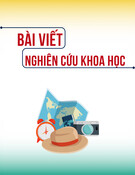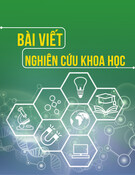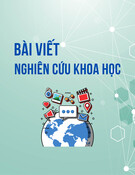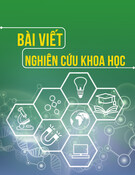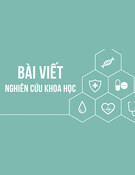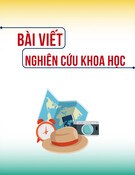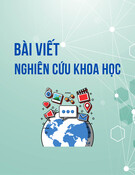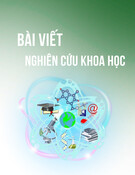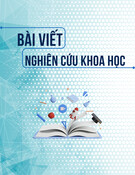
79
Sè §ÆC BIÖT / 2024
SOLUTIONS TO ENHANCE THE QUALITY OF BACHELOR'S DEGREE
TRAINING IN PHYSICAL EDUCATION AT BAC NINH SPORTS UNIVERSITY
Summary
By employing regular scientific research methodologies in physical education and sports, this
study has identified four key solutions to improve the quality of training for bachelor’s degree
programs in Physical Education at Bac Ninh Sports University. These solutions aim to meet society's
evolving needs and demands.
Keywords: Strategies, Bachelor's degree, Physical Education, Bac Ninh Sports University.
(1)PhD, (2)Master, Bac Ninh Sports University; (3)PhD, People’s Police Academy
(4)Master, Personnel and Organization Department, Hanoi Police Department
Nguyen Huu Hung(1); Vu Thi Mai Phuong(2); Dang Thi Thu Thuy(2)
Tran Thi Thu Hang(3); Nguyen Duy Thanh(4)
INTRODUCTION
In alignment with the Party and State’s
directives on comprehensive educational
reform, alongside the imperative to
continuously enhance the quality of Bachelor
training in Physical Education to address
societal demands, the Physical Education
Department at Bac Ninh Sports University has,
over the years, implemented various strategies
to improve training quality. However, expert
evaluations suggest that the current curriculum
for the Physical Education major has yet to
satisfy societal needs fully, nor does it entirely
align with the preferences and aspirations of the
students. Consequently, there is an urgent need
for a comprehensive reform of the Physical
Education curriculum, ensuring it is
modernized, aligned with professional
requirements, and responsive to real-world
demands.
RESEARCH METHODS
The study employed a combination of
research methodologies, including document
analysis and synthesis; pedagogical observation;
expert interviews; SWOT analysis; and
statistical analysis using mathematical methods.
RESULTS AND DISCUSSION
Based on an evaluation of the current state of
Bachelor training quality for Physical Education
at Bac Ninh Sports University, the study applied
a SWOT analysis and conducted expert
interviews to identify strategic solutions aimed
at improving training quality. These solutions
are projected to be implemented by 2025, with
a long-term vision toward 2030. The results are
presented in Tables 1 and 2.
The analysis in Table 1 reveals the results of
the SWOT analysis, highlighting four solution
groups with 20 detailed elements across the
following categories: Strengths group (S): six
elements were identified (S1 to S6), Weaknesses
group (W): eight elements were identified (W1
to W8), Opportunities group (O): seven
elements were identified (O1 to O7) and Threats
group (T): six elements were identified (T1 to
T6). This provides a scientific foundation for
further analysis of the SWOT matrix and expert
interviews to select appropriate solutions.
The results from Table 2 show that all four
proposed solutions, derived from the SWOT
analysis, fall into the following categories: S-O
Group (Leverage strengths, seize opportunities),
S-T Group (Leverage strengths, overcome
threats), W-O Group (Seize opportunities,
address weaknesses) and W-T Group (Address
weaknesses, mitigate risks). The solutions
received total scores between 33 to 36 points,
corresponding to Likert scale averages of 2.8 to
3.0, indicating a high prioritization level for
these solutions.
CONCLUSION
This study has identified four priority
solutions to enhance the quality of the
Bachelor’s degree program quality in Physical
Education at Bac Ninh Sports University,

p-ISSN 1859-4417 e-ISSN 3030-4822
80
Table 1. SWOT Analysis Evaluating the Current Status of Bachelor’s Degree Training
Solutions for the Physical Education Major at Bac Ninh Sports University
S (Strength) W (Weakness)
- S1. With over 62 years of formation and
development, the Physical Education
Department has a long history, closely tied to Bac
Ninh Sports University - the nation's leading
institution in training and providing high-quality
human resources.
- S2. The objectives and curriculum of the
Physical Education major hold a central and
significant role in the university’s overall training
system.
-S3. The young teaching staff benefits from
strong traditions, possessing enthusiasm, a desire
for learning, professional ethics, and a strong
political foundation.
-S4. Students majoring in Physical Education are
placed at the center of the educational process,
receiving a robust outcome in skills, theory, and
knowledge. They are also dynamic, creative, and
well-supported, with career counseling and
orientation beginning from the first year, laying
the groundwork for a bright future.
-S5. The department plays a key role in
organizing events and fulfilling major political
tasks for the university, the sports sector, and the
country.
-S6. Strong relationships exist with political and
social organizations, associations, federations,
and external businesses.
- W1. Facilities and training equipment,
including practice fields, remain insufficient,
failing to meet the requirements for curriculum
development in the modern era.
- W2. Although the curriculum is regularly
updated, it has yet to keep pace with societal
advancements.
-W3. The teaching staff, while young and
energetic, lacks experience and is limited in
number, with gender imbalance and varying levels
of expertise in professional theory and research.
-W4. The number of Physical Education students
remains low annually, insufficient to meet the
high societal demand, resulting in a significant
imbalance between supply and demand.
- W5. After eight semesters, students have yet
to fully develop specialized skills. Their
practical problem-solving abilities and overall
performance in specialized subjects show
inconsistencies.
- W6. The primary income source for staff is
limited to salaries and it’s insufficient to meet
personal, family, and societal needs.
- W7. Learning resources for specialized
training remain inadequate, and the pace of
digital transformation is slow. - W8. The
capacity for expanding training services and
socializing financial resources remains
underdeveloped, limiting the university's path
to autonomy.
O (Opportunity) T (Threat)
- O1. Government, Ministry of Information and
Tourism, and Ministry of Education and
Training directives (e.g., Decision 641/QĐ-
TTg; Decision 1070/QĐ-TTg; Circular
32/2018/TT-BGDĐT) emphasize the
fundamental and comprehensive reform of
education.
- O2. Strong support from political entities,
ministries, and local authorities, along with the
collective confidence in Bac Ninh Sports
University's rich tradition and development
potential.
- T1. There is a lack of professional
development programs for both internal and
external experts, limiting the ability of the
teaching staff to fully implement new
curricula.
- T2. Economic pressures, such as caring for
family and seeking additional income, hinder
the ability to invest in professional
development and research.

81
Sè §ÆC BIÖT / 2024
O (Opportunity) T (Threat)
- O3. The university leadership, in close
coordination with its functional units, is determined
to drive progress, with the full support and direction
of the Physical Education Department.
- O4. A growing engagement of organizations,
individuals, and businesses, both inside and outside
the university, in supporting training activities.
- O5. The leadership’s dedication and expertise serve
as a crucial driving force for improving the training
quality of Physical Education students, with strategic
goals set for 2025 and a vision for 2030.
- O6. The Bachelor training of the Physical
Education Department plays a critical role in the
university’s development, contributing to the supply
of highly skilled professionals to meet the market
demands of the new era.
- O7. Students majoring in Physical Education
demonstrate strong professional orientation, creating
a foundation for building a robust, professional
sports ecosystem that effectively meets societal
needs.
- T3. Limited budget allocations for
learning resources and textbooks result in
fewer publications, failing to meet the
growing demands of specialized training.
- T4. A segment of students lack academic
motivation, and they are affected by
financial hardships or influenced by peer
pressures related to part-time employment.
- T5. As society evolves, students face
increasing distractions (e.g., technology,
entertainment), leading to a decline in
extracurricular engagement compared to
previous generations.
- T6. The education system, including the
training of Physical Education majors, is
facing significant challenges with the
digital transformation process by 2025,
with a vision towards 2030.
The model of learning combined with physical training in schools at educational
institutions around the world

p-ISSN 1859-4417 e-ISSN 3030-4822
82
Table 2. Results of Interviews for Selecting Solutions to Enhance Bachelor’s Degree
Program Quality in Physical Education at Bac Ninh Sports University (n=12)
No Solution Priority 1 Priority 2 Priority 3 Result
miPoint miPoint miPoint Total Likert
1
GSolution 1 (S-O group): Update
the curriculum, objectives,
outcomes, content, methods, tools,
and resources to align with learner
competencies and social demands
(S-O group).
12 36 000036 3
2
GiSolution 2 (S-T group):
Develop lecturer capacities
through direct teaching combined
with digital transformation, create
a training plan, and advise the
university on management and
recruitment.
9 27 241130 2.7
3
Solution 3 (W-O group): Promote
learner-centered education
focusing on developing
competencies to encourage
knowledge mastery and prepare
for future careers.
10 30 121133 2.8
4
Solution 4 (W-T group): Enhance
the use and efficiency of current
infrastructure to support curricular
and extracurricular activities.
11 33 120035 2.9
aligned with societal needs. These solutions,
formulated based on scientific methods, are
applicable to the actual educational setting,
contributing to improving the quality and
effectiveness of training high-level human
resources in physical education and sports to
meet social demands.
REFERENCES
1. Asmarin, B.A. (1973), Theory and
Methodology of Practical Experiments in
Physical Education, Translated by Bùi Thế
Hiển, Sports Publishing House, Hanoi.
2. Vũ Văn Tảo (2003), Innovating Teaching
Methods in Universities, Colleges, and
Secondary Teacher Training, Viet Nam
Education Publishing House, Hanoi.
3. Nguyễn Đức Văn (2000), Statistical
Methods in Physical Education, Sports
Publishing House, Hanoi.
4. Đỗ Thị Thúy Yến (2021), Enhancing the
Quality of Human Resources in Teacher
Education, Journal of Industry and Trade.
Available at: https://tapchicongthuong.vn.
5. Kelly, A.V. (1989), The Curriculum:
Theory and Practice (3rd ed.), Paul Chapman
Publishing Ltd.
Received 18/9/2024, Reviewed 24/10/2024,
Accepted 28/11/2024
Main responsible: Nguyen Huu Hung
Email: huuhung2710@gmail.com)

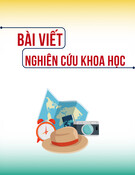
![Đề cương ôn tập Bản đồ du lịch [năm hiện tại]](https://cdn.tailieu.vn/images/document/thumbnail/2025/20250809/dlam2820@gmail.com/135x160/53061754884441.jpg)

